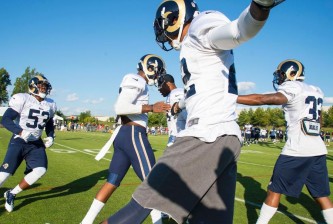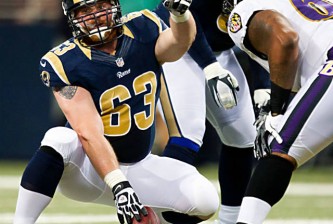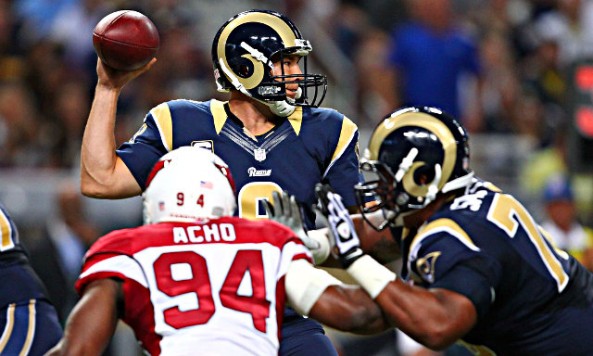"Battered quarterback syndrome (BQS)." Symptoms include jumpy feet, erratic throws and frustrated WRs unable to complete their routes before the whistle blows dead. Once the diagnosis is made, few have recovered.
Sam Bradford is one of those few.
In his first home preseason game in 2010, the Minnesota Vikings sacked Bradford 8 times in one half. It was his welcome to the NFL, and a harbinger of things to come. Over the next two seasons, Bradford was sacked 69 times in 26 games, and hit just as many more times. He led the league in being hit as he threw in both seasons, a sort of ignominious stat that combines toughness with total lack of protection.
By the end of 2011, the hits had taken their toll. His body had given out and his pocket discipline went with it. He showed all the symptoms of BQS.
After that season, the Rams cleaned house and were desperate to entice Jeff Fisher out of retirement and away from the similarly desperate Dolphins. The Rams offered him a blank check and full control, but Fisher had one make-or-break question: Did the Rams still have a quarterback? Or did they have the new David Carr?
It was a question that couldn't be answered by reviewing tape, or by looking at the stat sheet. By those measures, the answer would probably have been No. It was a question that Fisher needed to ask Bradford himself, face to face.
Whatever the young QB said or did in that meeting, it was enough to convince Fisher that there was more to Bradford than the tape or the stat sheet revealed. It was enough to convince him that there was still the core of a franchise quarterback under the bruised and battered exterior. Since then, Fisher and his hand-picked GM Les Snead have fully committed to Bradford, and completely remade the team around him. New center. New left tackle. New left guard. Four new receivers and a new playmaking tight end. New position coach, new offensive coordinator, new backup QB fully fluent in the new playbook.
Now, a year later, those pieces have come together and we’re starting to see Bradford’s core attributes shine through. And arguably, his success all starts with his protection up front.
The TD-Sack Comparison
Sacks are not counted in the traditional QB rating calculator, which gives fits to modern statisticians such as Football Outsiders’ Mike Tanier. Common sense says that a sack should be counted as what it is: a failed pass. Not quite as damaging as an interception, but more damaging than an incompletion. Sacks also contribute to the aforementioned battered quarterback syndrome.
One other maxim that Football Outsiders preaches: a quarterback is often more responsible for taking a sack than his offensive line. Mobility is not the issue here — vision is. The ability to rapidly diagnose pressure and coverage and find open receivers is far more prevalent than scrambling ability among the league’s toughest-to-sack quarterbacks. (Lead-footed Dan Marino had the NFL’s lowest sack percentage for seven consecutive years to start his career.)
Regardless of their playing styles, all franchise-worthy (read: Super Bowl contention-worthy) quarterbacks have a common trait in common – the ability to avoid bad plays while making good ones. In most lazy comparisons, we look at interceptions and touchdowns. However, the sack-touchdown comparison might be even more revealing. (Complete table here via Pro Football Reference)
To take an extreme example, look at Alex Smith. He has been able to dramatically improve his passer rating by all but eliminating interceptions from his game. He threw 30 touchdowns vs only 10 interceptions with a 64% completion percentage for Jim Harbaugh, but Harbaugh still benched him. Why? Perhaps because he also took 68 sacks in that span of time, while playing behind the best offensive line in football. Smith had the league’s lowest interception percentage, and the league’s highest sack percentage in 2012. He still wasn’t seeing the field fast enough or well enough for Harbaugh’s liking, and lost his job accordingly.
This jibes with the critique of Sam Bradford as a “see-it, throw-it quarterback.” Yes, Bradford is a healthy +12 over his career if you compare touchdowns to interceptions. But if you compare touchdowns with sacks, the numbers are not so good.
In fact, his 2011 season was even worse than Smith’s. Bradford threw only 6 TDs and was sacked 36 times. His -30 score is tied with Blaine Gabbert for the worst rate of the past three seasons.
We can generally agree that Bradford improved in 2012, and it shows in this stat, but it still places him in some uncomfortable company.
(Outlier alert: Hey, look! There’s Super Bowl-winning Joe Flacco!)
But what this gross measure fails to do is show the trend line of Bradford’s progression. Here is how this stat looks week to week, from the beginning of the season to the end. As you can see, there is a marked upward trend, pivoting around the midpoint of the season.
Now, is this statistical noise, or did something significant happen at the midpoint of the season (asks the pedant, knowing the answer already)?
The answer: Sam’s offensive line started to get healthy. Rodger Saffold returned to the line in Week 10, and Scott Wells returned in Week 12. Wells’ return had a two-fold benefit, as the veteran is responsible for making line calls, and his backup Rob Turner could slide over to fill the leaky left guard position.
In fact, since the midpoint of last season, Bradford has thrown 15 TDs and been sacked only 12 times. And his mechanics have never looked more solid than they did last Sunday.
Ironically, this modestly impressive +3 ratio puts him in company with his Week 2 opponent, Matt Ryan. Ryan has had a positive TD-Sack ratio every year from 2009-2012, and stands at 129-116 for his career. However, if Bradford is trending up, Ryan may be trending down as his offensive line crumbles. His field vision is still very good, and his offensive playmakers are elite, but he still suffered three sacks and had very jumpy pocket mechanics in a week 1 loss.
For those who want to question whether Bradford is improving (he is), or whether an improved Bradford is “merely average” or capable of something more, this upward trend bears close watching.























